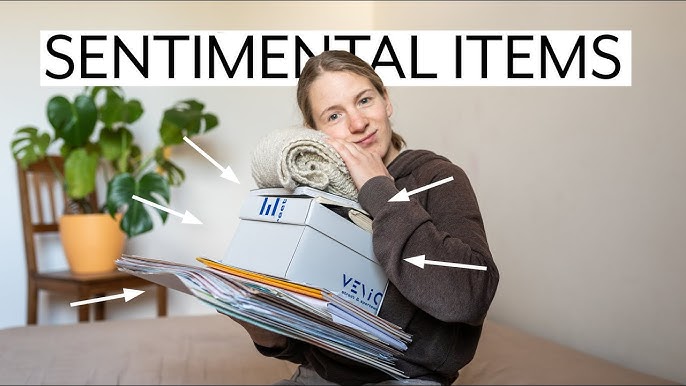It’s about simplicity, intentionality and freed from clutter. Because so many everyday items are easy to declutter—clothes, kitchenware, for instance—doing so can feel straight forward, but dealing with the sentimental bits is a different proposition. Gifts, family heirlooms, and old childhood keepsakes. All have emotional significance and so are hard to let go.
In this article, we’ll see how a minimalist approaches sentimental items, and how you can declutter mindfully, while saving the memories too. But if you’re having a hard time keeping your emotional attachments in check with your minimalist goals, and want to set some goals for yourself to try to reach, then this guide is just for you.

What Are Sentimental Items and Why Do They Matter?
Personal belongings such as sentimental items are things that stir up emotions or memories of what’s past. They are physical mementos of people and events we are thankful for. For examples:
- Or wedding gifts or anniversary mementos.
- Or childhood toys, artwork or school awards.
- Any souvenir from travels or vacations.
- Things that were inherited from parents or grandparents.
- Notes or cards written on handwritten, a journal.
These possessions may mean so much to you personally, but to these possessions can grow so much over time, both physically and mentally. For the minimalist, this is important stuff and learning to navigate what to throw in and what to take out is important in creating a harmonious, meaningful living space.
Why is letting go of sentimental items so hard?
Emotional Ties
Yet many items of sentiment are, through the inclemency of time, inextricably linked with cherished memories, relationships, or past experiences. It can also feel like you are letting go, loose a piece of the you. Or, you’re dishonoring those memories.
Fear of Forgetting
One of the reasons why people are afraid to give away something is that they worry about forgetting the person, the event, the feeling associated to this item. In this fear, you may take unnecessary things out of the guilt or anxiety.
Guilt and Obligation
Sentimental items handed down through generations or from people you love, can be accompanied with a sense of responsibility. It’s disrespectful or ungrateful to part with them.
Over-Identification with the Past
Some items are specific to a time in your life or a time when you accomplished something. It may feel like you’re keeping them, as if you were preserving your identity; letting them go might feel like you’re erasing part of your history.
The Minimalist Approach to Sentimental Items
Minimalism doesn’t mean getting rid of all sentimental stuff. Instead, it forces intentionality — keeping the only things that truly resonate with your values and make your soul swell. Managing sentimental belongings while paving the way toward minimalist living is something you can achieve with these strategies.
Step No.1:
Define Your Minimalist Goals
And first of all, make sure you know why you want to adopt minimalism. Is it to cut stress, live more intentionally, or give more physical and mental space? If we are making difficult decisions about sentimental items, reminding ourselves of these goals can help us clear our heads and get driven.
For Example:
- If you want to eliminate clutter from your space, it’s worth asking yourself if a sentimental item contributes to that overwhelming feeling you have about it.
- So if simplicity is the winner, then ask if the thing offers a meaningfulness or, often in the negative, complexity to your life.
Step No.2:
Collect Everything in One Place
Designate yourself a space to weed through your sentimental. It could be old photo albums, souvenirs, letters and keepsakes. When you see everything at once you can see what you are dealing with, what is important and what is not.
By sorting by category (photos, letters, gifts) the process becomes more manageable.
Step No.3:
Take It Slow
Yet decluttering sentimental items is an emotional process. It is easy to rush through it and regret or burn out. Begin with the smallest area of any kind…one category or items within this category (if possible). Keep going and maintain motivation as you celebrate your progress.
Step No.4:
Think about What Each Item Is For
For every item that you handle, ask yourself these questions.
- Why am I holding onto this?
- Is it something that gives me joy, or does it tie back to some sense of guilt or obligation?
- If I wouldn’t remember this person or this event, would I remember it without this item?
- Is this an item I want to live my life by?
It doesn’t mean you’re leaving something you hold in memory or to the person behind the object. Memory is, more accurately, stored in your heart, not in objects.
Step No.5:
It’s Time to Digitize Your Sentimental Belongings
Digitization is one of the best ways you can keep the essence of sentimental items without the physical items. It helps you save physical space and allows you to go back and revisit the memories again at any time.
Idea for digitization:
Photos
Store old photographs on hard drive or cloud storage and scan them. Make it a digital album that remains on the shelf easy at hand.
Letter and Cards
Compile together good quality scans or photos into a digital scrapbook.
Keep sakes
Before donating or discarding them, take pictures of the objects.
Digitizing allows you to preserve the memories without losing your minimalist ideals.
Step No.6:
Create a Memory Box
Position yourself with a small box or container to house those items you simply cannot live without intellectually. You need to prioritize and only take in things that are most important while being limited in space.
Minimalist tips for a memory box
- Picking a nice container that won’t be seen is so you can respect the contents in that can.
- Walls are your friend if you’re looking to minimize space, so find a balance between minimizing space and a box size that suits your minimalist ambitions.
- Make sure its contents are still relevant, re re assess periodically.
Step No.7:
Repurpose and Display Meaningful Items
- Make a quilt from old t shirts.
- Cut out frame-able letters, cards, and/or artwork to display.
- Instead of locking them away, use family china or vintage items in your everyday life.
Repurposing lets you keep sentimental items and repurpose them into your current lifestyle.
Step No.8:
Let Go with Gratitude
Parting with a sentimental object is a bidirectional process — concentrate on it being only positive. Admit how it served you and what it meant to you.
- Give to someone that will really appreciate or use the item.
- Share heirlooms with your family members who you think might value them.
- Get items that were no longer used
Step No.9:
Become Relationship and Experience focused
Minimalism teaches to value relationships and to live in the present. Turn everything you have into new memories and new connections with people you love — let go of things that only serve to keep you tethered to the material past.
Reasons Why It’s Beneficial To Get Rid Of Sentimental Items
It’s hard to declutter sentimental items but it also has a lot of psychological and emotional benefits:
1. Freedom from the Past
It’s about letting go so you can release the burden of old memories and can continue overcoming in the present and future.
2. Reduced Stress
It helps us live in a clutter free environment, resulting in aiding mental clarity, reducing stress and fostering a more calm environment.
3. Deepened Appreciation
Curation of those sentimental items you decide to keep can help truly cherish the items you keep.
4. Enhanced Gratitude
When reflecting on sentimental items the experience and relationship they represent can also make us grateful.
Common Misconceptions About Sentimental Decluttering
Myth No.1:
Letting Go Means Forgetting
Truth
Memories live within you, not in objects. Giving up doesn’t eliminate the past, but it does make space for new ones.
Myth No.2:
Keeping an Item Equals Love
Truth
Possessions don’t tie you to your relationships, memories. It doesn’t mean they become less important when you let them go.
Myth No.3:
All Sentimental Items must be Parted with by Minimalists
Truth
But minimalism is not about deprivation; it’s about intentionality. With regards to keeping meaningful items that are aligned with your values.
Final Thoughts (Conclusions)
That said, learning how to manage sentimental items as a minimalist, takes patience, self reflection and being intentional. The process will be emotionally difficult, but it will serve to create a life that directly aligns with your current priorities and values.
Letting go of what doesn’t serve you anymore allows space for things that do, like new memories, fabulous connections, a more substantial life. Remember, minimalism is not about doing without, it’s about living like you have something to live for.
Today takes the first step, freeing yourself from the control you gave to sentimental belongings, and learn how to mindfully manage what you feel.



Your article helped me a lot, is there any more related content? Thanks!
thankyou. You can visit website more related article
I don’t think the title of your article matches the content lol. Just kidding, mainly because I had some doubts after reading the article.
I don’t think the title of your article matches the content lol. Just kidding, mainly because I had some doubts after reading the article.